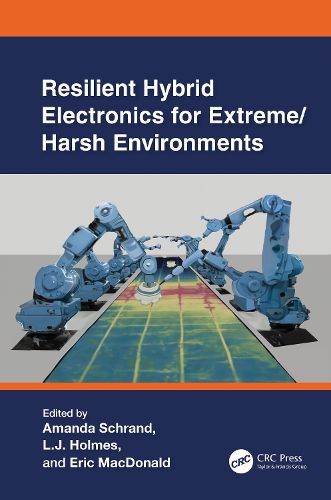Readings Newsletter
Become a Readings Member to make your shopping experience even easier.
Sign in or sign up for free!
You’re not far away from qualifying for FREE standard shipping within Australia
You’ve qualified for FREE standard shipping within Australia
The cart is loading…






The success of future innovative technology relies upon a community with a shared vision. Here, we present an overview of the latest technological progress in the field of printed electronics for use in harsh or extreme environments. Each chapter unlocksscientific and engineering discoveries that will undoubtedly lead to progression from proof of concept to device creation.
The main topics covered in this book include some of the most promising materials, methods, and the ability to integrate printed materials with commercial components to provide the basis for the next generation of electronics that are dubbed "survivable" in environments with high g-forces, corrosion, vibration, and large temperature fluctuations. A wide variety of materials are discussed that contribute to robust hybrid electronics, including printable conductive composite inks, ceramics and ceramic matrix composites, polymer-erived ceramics, thin metal films, elastomers, solders and epoxies, to name a few. Collectively, these materials and associated components are used to construct conductive traces, interconnects, antennas, pressure sensors, temperature sensors, power inducting devices, strain sensors and gauges, soft actuators, supercapacitors, piezo ionic elements, resistors, waveguides, filters, electrodes, batteries, various detectors, monitoring devices, transducers, and RF systems and graded dielectric, or graded index (GRIN) structures. New designs that incorporate the electronics as embedded materials into channels, slots and other methods to protect the electronics from the extreme elements of the operational environment are also envisioned to increase their survivability while remaining cognizant of the required frequency of replacement, reapplication and integration of power sources. Lastly, the ability of printer manufacturers, software providers and users to work together to build multi-axis, multi-material and commercial-off-the-shelf (COTS) integration into user-friendly systems will be a great advancement for the field of printed electronics.
Therefore, the blueprint for manufacturing resilient hybrid electronics consists of novel designs that exploit the benefits of advances in additive manufacturing that are then efficiently paired with commercially available components to produce devices that exceed known constraints. As a primary example, metals can be deposited onto polymers in a variety of ways, including aerosol jetting, microdispensing, electroplating, sintering, vacuum deposition, supersonic beam cluster deposition, and plasma-based techniques, to name a few. Taking these scientific discoveries and creatively combining them into robotic, multi-material factories of the future could be one shared aim of the printed electronics community toward survivable device creation.
$9.00 standard shipping within Australia
FREE standard shipping within Australia for orders over $100.00
Express & International shipping calculated at checkout
The success of future innovative technology relies upon a community with a shared vision. Here, we present an overview of the latest technological progress in the field of printed electronics for use in harsh or extreme environments. Each chapter unlocksscientific and engineering discoveries that will undoubtedly lead to progression from proof of concept to device creation.
The main topics covered in this book include some of the most promising materials, methods, and the ability to integrate printed materials with commercial components to provide the basis for the next generation of electronics that are dubbed "survivable" in environments with high g-forces, corrosion, vibration, and large temperature fluctuations. A wide variety of materials are discussed that contribute to robust hybrid electronics, including printable conductive composite inks, ceramics and ceramic matrix composites, polymer-erived ceramics, thin metal films, elastomers, solders and epoxies, to name a few. Collectively, these materials and associated components are used to construct conductive traces, interconnects, antennas, pressure sensors, temperature sensors, power inducting devices, strain sensors and gauges, soft actuators, supercapacitors, piezo ionic elements, resistors, waveguides, filters, electrodes, batteries, various detectors, monitoring devices, transducers, and RF systems and graded dielectric, or graded index (GRIN) structures. New designs that incorporate the electronics as embedded materials into channels, slots and other methods to protect the electronics from the extreme elements of the operational environment are also envisioned to increase their survivability while remaining cognizant of the required frequency of replacement, reapplication and integration of power sources. Lastly, the ability of printer manufacturers, software providers and users to work together to build multi-axis, multi-material and commercial-off-the-shelf (COTS) integration into user-friendly systems will be a great advancement for the field of printed electronics.
Therefore, the blueprint for manufacturing resilient hybrid electronics consists of novel designs that exploit the benefits of advances in additive manufacturing that are then efficiently paired with commercially available components to produce devices that exceed known constraints. As a primary example, metals can be deposited onto polymers in a variety of ways, including aerosol jetting, microdispensing, electroplating, sintering, vacuum deposition, supersonic beam cluster deposition, and plasma-based techniques, to name a few. Taking these scientific discoveries and creatively combining them into robotic, multi-material factories of the future could be one shared aim of the printed electronics community toward survivable device creation.